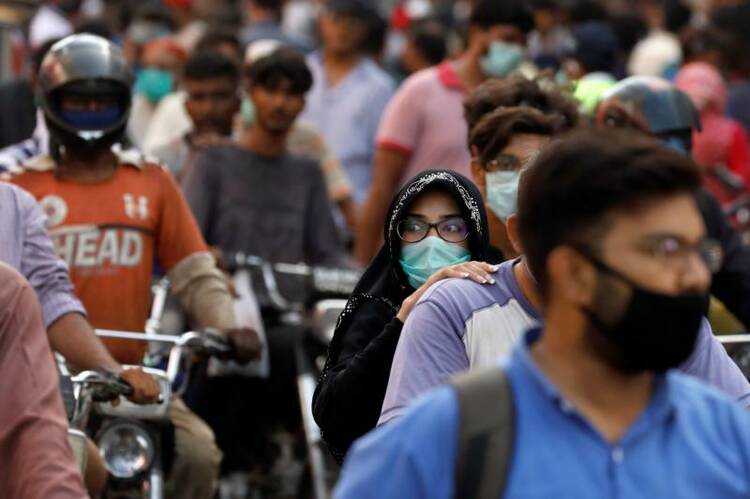DHAKA, Bangladesh (CNS) -- The COVID-19 pandemic might have hit South Asia a little late, but the damage has already been done.
More than three months after the ordeal began, the region's 1.7 billion people, one fifth of the world's population, are passing their days and nights in fear of a grave human tragedy, said an analysis published by ucanews.com.
Major South Asian countries have seen a jump in daily infections from a month ago. In early May, Bangladesh was recording 400-500 infections; now it averages 2,500 a day. India has been registering about 10,000 new cases daily, up from about 2,500 in May.
Infections and deaths continue to surge in the region every day, yet India, Pakistan, Bangladesh, Sri Lanka and Nepal have eased nationwide lockdowns that somewhat managed to tame the virus but failed to stop it.
Fears are running extremely high that at the current pace of infection, with the number of cases and fatalities doubling every two weeks, the pandemic is headed for a peak by the end of July.
By that time, the number of confirmed cases might reach 5 million and the death toll could surpass 150,000 given that population density in South Asia is among the highest in the world.
Current trends in most South Asian nations indicate that the easing of the restrictions and heath emergency rules are most likely to fuel the spread of the pandemic that has rocked even the richest and most developed countries in the West.
South Asia's massive population, extreme poverty, weak human resources and poor health care systems provide perfect conditions for a looming humanitarian disaster.
With more than 434,000 confirmed cases and more than 10,200 deaths, South Asian nations are on course to overhaul the West, where nations have better social security and health care services.
Health experts fear the real numbers of infections and deaths could be much higher given that South Asian governments failed to conduct large-scale testing.
South Asia is home to one-third of the world's poor, who live in overcrowded and unsanitary urban slums and rural areas with extremely low nutrition levels. Not surprisingly, they have been the most affected by COVID-19.
While the rich are a minority in South Asia, they have the privilege of maintaining physical distancing and good hygiene as they live in spacious houses with sufficient rooms, doors and attached toilets. These are nothing less than luxuries for the poor.
Indian Prime Minister Narendra Modi gave 1.3 billion people only four hours' notice before declaring a nationwide lockdown, putting the lives of millions of poor migrant workers at grave risk. Scores died without food and in road accidents as they trekked hundreds of miles to get home.
Some 20 million Indian migrant workers from urban slums with high infection rates traveled back home, and that is how the disease spread all over the country. Bihar, one of India's poorest states, has traced one-third of COVID-19 cases to returnees from large cities.
India has failed to flatten the curve of the virus despite having a highly applauded and effective coronavirus-slaying model in Kerala state. India has nearly 270,000 coronavirus cases, fifth-worst in the world.
Pakistani Prime Minister Imran Khan stated several times that he considered the lockdown a mistake that would hit the poor hard, yet it was enforced halfheartedly.
Bangladesh did not go for a nationwide lockdown except in some highly infected areas. It sounded odd when the country declared a general holiday from March 26 and it was extended until May 30.
Millions of mostly poor and low-income people thought it was a holiday and left the cities for their villages on crowded public transport, raising the risk of massive community transmission. Shocked and surprised, the government declared a ban on public transport, but it was too late.
Since the pandemic struck in China and the West, Bangladesh failed to halt international flights and thus thousands of expatriate workers returned home and brought the virus with them.
Then, under pressure from businessmen, the government allowed the reopening of garment factories, forcing millions of workers to return to workplaces, which increased the risks of infection.
Sri Lanka was relatively successful with a strict lockdown and registered 1,835 cases and 11 deaths. The pandemic "impacted Sri Lanka's economy with a fall in earnings from tourism, remittances and outflow of foreign investment," the central bank noted.
The World Bank estimates that regional growth will fall to a range of between 1.8% and 2.8% in 2020, the worst economic performance in 40 years. The average per capita income of eight South Asian nations was about $1,900 in 2018, compared to $9,700 in China.
An economic slump in South Asia means people on the lower rungs will lose work, income and slip further into poverty, and inequality will increase sharply. The region's rich and elites will continue to thrive when governments cut public spending on vital sectors such as health and education.










